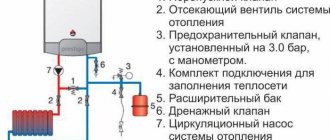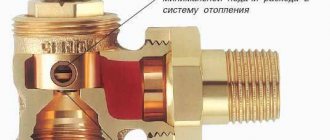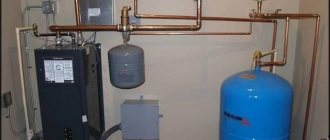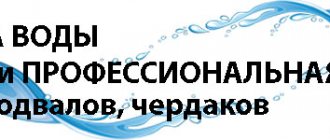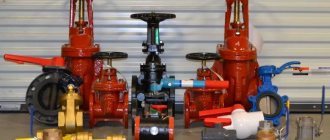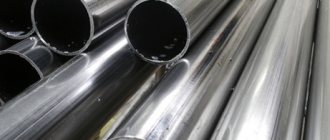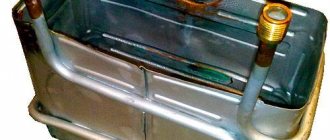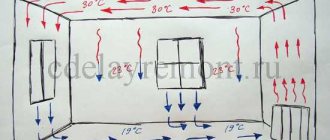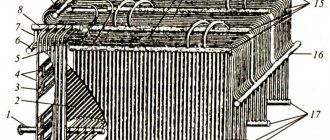When installing radiators for a heating system, you also need to take care of purchasing control shut-off valves. With their help, it will be possible to regulate the flow of coolant into the system, due to which you can maintain the most comfortable conditions in the room. Such regulating shut-off valves for radiators must be of high quality and reliable, which will allow them to be used for many years. All these requirements are met by the products of Valtec, which has been producing such products for many years now and today occupies one of the leading positions in the production and sale of such plumbing fixtures.
Direction of coolant circulation
The lower saddle connection of the batteries using a lower vertical collector allows you to not depend on the direction of coolant supply. This cannot be said about the lateral and diagonal leash, as well as when radiators with a bottom connection point are used: here the supply must be clearly adjusted. Otherwise, the heating of the device may stop completely, or it will heat up very weakly. A lateral or diagonal connection involves the use of a top feed (the return pipe in this case comes from below).
When installing a bimetallic radiator with a bottom connection, it is important to clarify in advance which of the inputs will be connected to the supply. Usually this information is indicated in the passport
It is important not to confuse the directions, because... The supply in such heating devices is equipped with a tube extending upward from the inlet assembly. With its help, the coolant is brought to the upper collector. After this, it spreads over the radiator.
Radiator valves
Shut-off and control valves / Valves for radiators in the online store TEPLOTOK.RF - Moscow
We will manufacture a boiler, hydraulic accumulator, gas receiver, heat or cold accumulator, tank (RGS/RVS) up to 10,000 m3
more details
8 (495) 369-04-18
Opening hours: Mon.-Fri. 09:00-19:00
0 R
- Cart Checkout
- Your basket is empty!
- Shut-off and control valves
Catalog
- Burners for boilers
- Boiler room fittings
- Quick assembly groups
- Hydroshooters
- Accessories
- Stainless steel
- For water supply
- Balancing valves and valves
- For metal-plastic pipes
- Autonomous circulation groups
- Floor recessed
- Fuel level indicators
- Gas
- For water supply
- Drainage
- Air vents
- Relay
- Water meters
- Cast iron radiators
- Putties
- Bidet
- Controllers for solar systems
- Heating cables
- For walls
- Copper
- For ventilation systems
- For sewer pipes
- Emergency lighting
- Socketless pipes SML SML pipes
- Groove couplings
Brands
- ACV
- Aquatech
- Arbonia
- Atoll
- Austria Email
- Axis
- Banninger
- Barberi
- Baxi
- BestFix
- Bosch
- Bradford White
- Broen
- Buderus
- Bugatti
- Cimm
- Cordivari
- Cordivari Design
- Cyclon
- Danfoss
- De Dietrich
- Drazice
- Duravit
- ESBE
- Elco
- Empur
- Energoflex
- FAR
- Ferroli
- Firat
- Flamco
- Gala
- Geberit
- Geesa
- Giacomini
- Giersch
- Global
- Gorenje
- Grohe
- Grundfos
- Gustavsberg
- Hajdu
- Hansgrohe
- Herz
- Honeywell
- Huch EnTEC
- IFO
- Ideal Standard
- Itap
- Itelma
- Jacob Delafon
- Jeremias
- Jika
- K-Flex
- Kalde
- Kaldewei
- Kampmann
- Keramag
- Kermi
- Kiturami
- Conner
- Kospel
- Lammin
- Laufen
- Luxor
- Meibes
- Mohlenhoff
- NED
- Nobili
- Oras
- Ostendorf
- Oventrop
- Prandelli
- Protherm
- RSP
- Ravak
- Reflex
- Rehau
- Rems
- Resol
- Rifar
- Roca
- S-Tank
- SYR
- Sanha
- Santek
- Sime
- Sinikon
- Solira
- Stout
- Sunsystem
- Teplocom
- Thermaflex
- Thermo
- Tiemme
- Tyco
- Unipak
- Uponor
- VILLEROY & BOCH
- Vaillant
- VarioTherm
- Varmann
- Viadrus
- Viega
- Viessmann
- Wattek
- Watts
- Wilo
- Wolf O
- iTermic
- Aqua guard
- Anion
- Gallop
- Grota
- Gilex
- Designstal
- Neptune
- Politek
- Rusnit
- ReCo
- Special automation
- HEAT FLOW
- Evan
- Energoflex
Product filter
Compare products (0)
Filter
STOUT Flat seal adapter
Manufacturer: Stout 48.70 R 54.70 R-10%
STOUT Adapter for radiators with 1/2″ x 3/4″ BP
An adapter for radiators is necessary in circumstances where the technological hole of the radiator does not coincide with the cross-sectional diameter of the heating pipe
Manufacturer: Stout
70.40 R 78.70 R-10%
LUXOR VT 2600 Handwheel for thermostatic valve
The LUXOR VT 2600 handwheel is used with thermostatic valves.
The handle and fixing ring are made of plastic. Maximum temperature Manufacturer: Luxor
112.10 R 124.60 R-10%
STOUT Manual thermostatic valve, angular 1/2
The valves were developed in collaboration with leading specialists from Europe.
The body is made of brass. Distinctive features of the product from STOUT: increased throughput Manufacturer: Stout
236.30 RUR 263.30 RUR-10%
STOUT Manual thermostatic valve, angled 1/2″
Manufacturer: Stout 264.10 R 294.20 R-10%
STOUT Manual thermostatic valve, straight 1/2
The valves were developed in collaboration with leading specialists from Europe.
The body is made of brass. Distinctive features of the product from STOUT: increased throughput Manufacturer: Stout
256.20 R 285 R-10%
STOUT Manual thermostatic valve, straight 1/2″
Manufacturer: Stout 286.60 RUR 319.30 RUR-10%
STOUT Manual thermostatic valve with non-lifting spindle, angled 1/2″
Manufacturer: Stout 297.10 RUR 330.80 RUR-10%
LUXOR easy DS 122 1/2"
LUXOR thermal equipment is made of high-quality and environmentally friendly materials, reliably performs the necessary functions, is easy to install and has excellent
Manufacturer: Luxor
302.90 RUR 336.50 RUR-9%
LUXOR easy DD 121 1/2"
LUXOR thermal equipment is made of high-quality and environmentally friendly materials, reliably performs the necessary functions, is easy to install and has excellent
Manufacturer: Luxor
308.50 RUR 342.80 RUR-10%
STOUT Manual thermostatic valve with non-lifting spindle, straight 1/2″
Manufacturer: Stout 322.20 R 358.20 R-10%
LUXOR easy DS 132 1/2"
LUXOR thermal equipment is made of high-quality and environmentally friendly materials, reliably performs the necessary functions, is easy to install and has excellent
Manufacturer: Luxor
306.80 RUR 340.80 RUR-9%
STOUT Bottom connection for radiator, separate 3/4″
The lower radiator connection unit has increased throughput and creates reduced resistance in the heating system.
No additional parts Manufacturer: Stout
345.70 RUR 384.60 RUR-10%
LUXOR easy DD 131 1/2"
LUXOR thermal equipment is made of high-quality and environmentally friendly materials, reliably performs the necessary functions, is easy to install and has excellent
Manufacturer: Luxor
330.30 R 367 R-9%
STOUT Bottom connection for radiator, angled, separate 3/4″
Manufacturer: Stout 352.60 RUR 392.60 RUR-10%
LUXOR easy RS 102 1/2"
LUXOR thermal equipment is made of high-quality and environmentally friendly materials, reliably performs the necessary functions, is easy to install and has excellent
Manufacturer: Luxor
349.60 RUR 388.40 RUR-9%
STOUT Manual thermostatic valve, 3/4 angular
The valves were developed in collaboration with leading specialists from Europe.
The body is made of brass. Distinctive features of the product from STOUT: increased throughput Manufacturer: Stout
351.80 R 391.40 R-10%
LUXOR tekna DS 22 1/2"
LUXOR thermal equipment is made of high-quality and environmentally friendly materials, reliably performs the necessary functions, is easy to install and has excellent
Manufacturer: Luxor
364.40 RUR 404.80 RUR-9%
Itap 396 1/2
Angle shut-off and control valve Itap 396 for use with steel pipes or, with Itap adapters, pipes made of copper, cross-linked polyethylene or
Manufacturer: Itap
278 R 408.20 R-31%
LUXOR easy RD 101 1/2"
LUXOR thermal equipment is made of high-quality and environmentally friendly materials, reliably performs the necessary functions, is easy to install and has excellent
Manufacturer: Luxor
371.70 R 413 R-10%
LUXOR tekna DD 21 1/2"
LUXOR thermal equipment is made of high-quality and environmentally friendly materials, reliably performs the necessary functions, is easy to install and has excellent
Manufacturer: Luxor
373 RUR 414.50 RUR-10%
STOUT Manual thermostatic valve, straight 3/4
The valves were developed in collaboration with leading specialists from Europe.
The body is made of brass. Distinctive features of the product from STOUT: increased throughput Manufacturer: Stout
368.30 RUR 409.70 RUR-10%
STOUT Manual thermostatic valve, angled 3/4″
Manufacturer: Stout RUR 397.80 RUR 442.90-10%
LUXOR easy RS 112 1/2"
LUXOR thermal equipment is made of high-quality and environmentally friendly materials, reliably performs the necessary functions, is easy to install and has excellent
Manufacturer: Luxor
373.60 R 415.10 R-9%
Meibes Cross connection unit Type D2/50 straight, 3/4″BPx3/4″HP 5/25
Manufacturer: Meibes RUR 3,908.10
Meibes Connection unit for panel radiators Type E2/50 angular, 3/4″BPx3/4″HP
Manufacturer: Meibes RUB 1,432.50
OVENTROP Return valve Combi 2 straight 3/4″ x 1/2″
Manufacturer: Oventrop 812.90 RUR 939.30 RUR-13%
LUXOR M351/A Block with bottom connection for two-pipe system, Eurocone
LUXOR M 351/A blocks are 4-way distributors for one-pipe and two-pipe radiator systems, with floor connection.
They have a double external seal and Manufacturer: Luxor
841.90 R 935.50 R-10%
OVENTROP Return valve Combi 2 straight 1/2″
Manufacturer: Oventrop RUR 720.90 RUR 833.40-13%
STOUT Manual thermostatic valve, straight 3/4″
Manufacturer: Stout 412.60 RUR 458.90 RUR-10%
Contact Information
- Moscow, st. 1st Magistralnaya 4с1
- 8
- [email protected]
- Your city: Moscow
Information
- About company
- Production
- Shipping and payment
- Returns and exchanges
- Installation
- Guarantee
- Contacts
Additionally
- Brands
- Gift cards
- Consent to processing
- CashBack
- News and articles
- Terms of sale
Personal Area
- Featured Products (0)
- Compare products (0)
- Entrance
- Registration
© TEPLOTOK 2014 — 2022 | Sales of engineering equipment
Turnkey internal engineering systems (heating, water supply, ventilation and air conditioning, sewerage) with delivery throughout Russia. ADSLab website development
Regulatory elements
Control valves are automatic and are designed to set and maintain the optimal temperature indoors.
If the climate in the room changes sharply, the system will work: the speed of coolant flow through the pipes will change, which will gradually return the indicators to normal.
Inside the regulator is a substance that changes its dimensions, depending on the situation in the heating system. When expanding, pressure is exerted on the valve rod, which smoothly shuts off the liquid supply.
The installed device should not be influenced by external factors; it should be located away from heating elements and direct sunlight. Do not cover it with curtains, push furniture in, or place the product near an air conditioner or ventilation hole.
Regulating products include thermal heads, check valve, bypass valve, and automatic air vent.
Shut-off and control valves in the heating system
The heating system can be assembled in different ways; inserting fittings changes the characteristics of the structure.
Possible pipeline layouts
All types of heating circuits are divided into single-pipe and double-pipe.
In the first case, a Leningrad pipe is often collected, where the water leaves the boiler, passes through the circuit through the house, and returns to the heat exchanger when it has cooled.
The disadvantage of the scheme is that the farther the radiator is from the boiler, the colder it is. In the far room, even with intense operation of the system, it will be much cooler than in the room closest to the point of hot water exiting the boiler.
Differences between single-pipe and two-pipe heating
Two-pipe heating has no drawbacks. There is a supply branch for hot coolant, and a return line for cooled moisture.
Thanks to separation, it is possible to achieve the same intensity of heating of rooms without additional energy consumption.
In what places and how are radiators installed?
Heating radiators are connected to the pipeline in one of three ways.
When joining sideways, the supply and return pipes are on one side, and on the other, the holes are closed with plugs.
Connection diagram for heating radiators
The diagonal diagram involves connecting the supply line from above, the return line through the bottom, on the other side of the radiator.
When connecting at the bottom, both branches pass through the lower holes of the heater.
Features of hydraulics in the heating system
Fuel is stable, regularly rising in price, the problem is saving. For this purpose, it became possible to adjust each radiator separately, for which shut-off and control equipment is used.
The possibility of sudden changes in pressure in different areas completely arbitrarily has been proven, although previously it was believed that heating was completely stable.
Using the data obtained, we began to formulate conditions under which the influence of water hammer would not be so strong on the system.
It has been proven that it is impossible to suddenly open or close ball valves; the resulting water hammers exceed arbitrary ones and lead to pipe ruptures.
Each regulator blocks individual parts of the structure, creating a pressure drop, causing turbulence, and becoming noisy.
Locking elements
In addition to ball valves, three-way valves are often used; they can shut off the coolant supply and redirect it to the bypass.
The universal Teflon balls inside the device do not require modification.
Regulating devices
The thermal head is an automatic regulator that is required to maintain comfortable conditions in a particular room.
If the temperature in the room changes, the sensor is triggered, the device brings the heating power to optimal.
Reverse flow valves prevent fluid from flowing back, preventing the formation of water hammer if the valve is closed abruptly.
When the heating temperature of the coolant changes, air bubbles often form, the entry of which reduces the energy efficiency of the system. To eliminate this, use automatic air vents.
The bypass valve maintains the adjusted pressure inside the pipes and reduces the amount of noise generated.
Safety valves are an emergency type of fittings; they protect heating from critical pressure - they discharge excess water.
Flexible inserts are used for noise reduction. It is impossible to completely get rid of sounds, but it is possible to reduce the amount.
Heating wiring diagrams
They are distinguished by the following characteristics:
- The number of pipes - single or double pipe. With a single-pipe distribution, hot water sequentially passes through all the radiators of one riser. It is clear that the first of them receives more heat, the last - less. Ensuring uniform heat distribution is achieved by using a tap at the battery inlet and a bypass - a pipe of smaller diameter that creates a path for water to bypass the radiator.
- The location of the risers is vertical or horizontal.
- Organization of circulation - natural or with an installed circulation pump.
When organizing a heating system for an apartment in a multi-story building, you have to rely on the already installed wiring. For example, in Soviet-built houses, single-pipe vertical distribution with a natural coolant circulation was used. When renovating such premises, you have to adapt to this, although it has more disadvantages than advantages. Strictly speaking, there is only one advantage - the length of the pipes is half that of the two-pipe version.
In modern construction, attention is constantly paid to saving energy resources. You can save heat, including by quickly regulating its output and choosing the optimal heating mode
Therefore, new buildings are often initially equipped with a two-pipe heating system. With higher initial costs, it opens up opportunities for effective management of energy consumption.
What is needed for installation
Installation of heating radiators of any type requires devices and consumables. The set of necessary materials is almost the same, but for cast iron batteries, for example, the plugs are large, and they do not install a Mayevsky valve, but instead, somewhere at the highest point of the system, they install an automatic air vent. But the installation of aluminum and bimetallic heating radiators is absolutely the same.
Steel panel ones also have some differences, but only in terms of hanging - they come with brackets, and on the back panel there are special arms cast from metal, with which the heater clings to the hooks of the brackets.
These are the arms that hook the hooks
Mayevsky crane or automatic air vent
This is a small device for releasing air that may accumulate in the radiator. Placed on the free upper outlet (collector). It must be on every heating device when installing aluminum and bimetallic radiators. The size of this device is significantly smaller than the diameter of the manifold, so you will also need an adapter, but Mayevsky taps usually come complete with adapters, you just need to know the diameter of the manifold (connection dimensions).
Mayevsky crane and method of its installation
In addition to the Mayevsky crane, there are also automatic air vents. They can also be installed on radiators, but they are slightly larger in size and for some reason are only available in a brass or nickel-plated case. Not in white enamel. In general, the picture is unattractive and, although they deflate automatically, they are rarely installed.
This is what a compact automatic air vent looks like (there are more bulky models)
Stub
The side-connected radiator has four outputs. Two of them are occupied by the supply and return pipelines, on the third they install a Mayevsky valve. The fourth entrance is closed with a plug. It, like most modern batteries, is most often painted with white enamel and does not spoil the appearance at all.
Where to install the Mayevsky plug and tap for different connection methods
Shut-off valves
You will need two more ball valves or shut-off valves that can be adjusted. They are placed on each battery at the input and output. If these are ordinary ball valves, they are needed so that, if necessary, you can turn off the radiator and remove it (emergency repairs, replacement during the heating season). In this case, even if something happens to the radiator, you will cut it off, and the rest of the system will work. The advantage of this solution is the low price of ball valves, the disadvantage is the impossibility of adjusting heat transfer.
Radiator taps
Almost the same tasks, but with the ability to change the intensity of the coolant flow, are performed by shut-off control valves. They are more expensive, but they also allow you to adjust the heat transfer (make it less), and they look better externally; they are available in straight and angular versions, so the piping itself is more accurate.
If desired, you can install a thermostat on the coolant supply after the ball valve. This is a relatively small device that allows you to change the heat output of a heating device. If the radiator does not heat well, you cannot install them - it will be even worse, since they can only reduce the flow. There are different thermostats for batteries - automatic electronic ones, but more often they use the simplest one - mechanical.
Related materials and tools
You will also need hooks or brackets for hanging on walls. Their number depends on the size of the batteries:
- if there are no more than 8 sections or the length of the radiator is no more than 1.2 m, two mounting points on top and one on the bottom are sufficient;
- For every next 50 cm or 5-6 sections, add one fastener at the top and bottom.
You also need fum tape or linen winding and plumbing paste to seal the joints. You will also need a drill with drills, a level (preferably a level, but a regular bubble one will do), and a number of dowels. You will also need equipment for connecting pipes and fittings, but it depends on the type of pipes. That's all.
https://youtube.com/watch?v=nnQz2VA7C_M
What to choose: taps or valves?
Radiators are an independent part of the heating circuit of a building, but installing add-ons will help avoid many difficulties.
For example, shut-off valves are needed so that the battery can be removed for routine cleaning and repairs without draining water from the system. The accumulation of air will not allow the radiators to heat up to the desired level; to solve the problem, you need an air release valve.
Ball valve
The ball product received this name because the locking part is a ball with a through hole.
The device operates in two positions - full opening, closing, it is impossible to partially adjust. The equipment is considered to be a shut-off device only and accompanies any radiators.
The taps are located at the inlet and return connection points, which will be closed.
Mayevsky crane
The element is a type of air vent, a completely mechanical device. The valve will not operate automatically when a gas lock forms; manual intervention will be required.
The part is placed in place of the top plug; to bleed air, it is carefully loosened with a flat screwdriver. The air will come out through a small hole with a characteristic sound.
The process is continued until the coolant begins to flow out in a more or less even stream.
Mayevsky’s product is not suitable for cast iron batteries; a strong drain of the coolant is required, which is impossible with a small hole.
Adjustment parts on radiators
The adjusting product is part of the closing fittings, but is installed in tandem with the ball and does not provide the required tightness.
It is possible to partially change the pressure of the liquid, and not immediately block it completely. Helps regulate temperature conditions.
It is necessary to remember about the low throughput of the device; installation is required when the house often gets hot.
Shut-off valves are part of the heating structure, without which the inertia of the system will soon cause it to fail. Products must be installed according to the rules.
Heating fittings overview:
Average score of ratings is more than 0
Share link
Comments There are no comments yet, but you could be the first...
Heating control valves
It is designed to control the operation of the heating system as a whole or in a specific area. This depends on the design and operating parameters. Let's consider the most popular and mandatory models for installation.
Mayevsky crane
Design of the Mayevsky tap
If the heating of a certain radiator has significantly deteriorated, there is a high probability of an air lock. To prevent overheating of the coolant, it is necessary to pre-install Mayevsky taps on each of the heating devices.
This heating control valve is a needle valve that is completely sealed when closed. Installed on the upper radiator pipe, in case of air pockets it helps to eliminate them. To do this, use a key or screwdriver to loosen the degree of pressure on the curtain. This is done until the characteristic sound of escaping air is heard. The procedure ends only when the coolant begins to flow.
Check valve
Check valve
Necessary to prevent reverse movement of water in pipes. It can be found in catalogs of heating fittings intended for both small private systems and central heating.
The operating principle of this device is based on the fact that the pressure of the water pressure acts on the valve seat, moving it away. As a result, fluid circulates in the pipes. If for some reason water begins to flow back, the valve returns to the closed state. This mechanism is necessary in systems with complex wiring of highways. In particular, it is mounted as a shut-off valve for heating radiators. This improves operational safety and increases the efficiency of the entire system.
Mixing units
Two way valve
To install a water heated floor, it is necessary to ensure mixing of hot and cold water. This is due to different temperature conditions in the heating pipes and underfloor heating. 2 or 3-way mixing units are used as the main mechanism.
Structurally, they are similar to needle taps. But in addition to the inlet and outlet pipes, they have additional connection points. Two-way models provide mixing of coolant flow with different temperatures by opening the rod to a certain height. In three-way designs, dampers are installed. Changing their location reduces or increases the flow of water.
Such control valves for heating can be controlled manually or automatically. For the latter, an electric drive is installed connected to a temperature sensor in the pipes or in the room. Depending on the set heating level, the position of the rod or damper is adjusted.
Safety valve
If the heating level of water in the pipes exceeds the specified parameter, a sharp rise in pressure occurs. To prevent a breakthrough, another type of heating shut-off valve is installed, the regulating functions of which are aimed at discharging excess water or air from the system.
The most popular of them is the safety valve. Unlike the Mayevsky tap, it is designed for higher pressures. In the event of an emergency, water pressure acts on the seat, causing the rod to rise. Excess coolant or air leaves the system, and the valve remains open until the pressure stabilizes. This shut-off valve for heating must be installed correctly. Experts recommend installation on the return pipe before it enters the boiler and before the circulation pump.
Brief overview of shut-off and control equipment for heating
Closing and control valves are parts of the heating system that are not related to the main heating equipment. Parts that are not a boiler, pump, expander, pipes, radiator.
Purpose of fittings
Overlapping parts are used to forcibly reduce the volume of passing coolant and completely stop circulation in a certain area.
The equipment creates a safe environment for the operation of the heating system. The elements regulate the level of in-pipe pressure, control the water temperature, adding cold water.
Adjustment devices control the operation of automation devices.
A popular material for heating fittings is ductile cast iron; brass is often used, less often copper. Due to the high susceptibility of the metal to corrosion, it is practically not used.
Shut-off valves
Closing elements are located at the entrance to the highway.
It is necessary that the diameters of the pipes and fittings coincide at the inlet and outlet; the installed valve should not interfere with the coolant.
Locking devices
You need the ability to adjust, on which the accuracy of changing the water pressure depends. Ball models perform the procedure quickly, wedge models more smoothly.
It is necessary to be able to install an automatic regulator that opens the valve.
Control valves
Regulating devices control the operation of the heating structure as a whole, in individual areas.
The group of fittings includes a check valve, a Mayevsky tap, and mixing units.
The Mayevsky valve bleeds air from heating pipes and helps to effectively eliminate gas plugs.
Reverse device
The check valve should create an obstacle to the reverse direction of water movement, increase the safety of devices, and increase efficiency.
Mixing unit
Mixing structures with two or three strokes are needed to mix hot water with cold. Knots are often found in heated floor structures.
Fittings for heating radiators
There is a wide range of similar elements on the market. The following are installed on heating radiators:
- radiator taps;
- thermal heads;
- Mayevsky cranes.
Radiator tap is a fitting for a smooth and uniform supply of coolant to the radiator of the heating system. It protects against sudden changes in pressure. There are corner and straight radiator taps. They are selected taking into account the design features of the installation.
Simple radiator valve
Due to the smooth adjustment, you can set the required level of coolant supply, taking into account the required temperature conditions in the room. Double insulation provides protection and makes the adjustment process more precise.
Thermal head
Comprises:
- housings;
- bellows;
- rod;
- pusher;
- return spring.
Adjusting head for radiator
The principle of operation is the effect of room air on a bellows located in a closed space. The filler expands, the bellows becomes larger and, through a rod with a pusher, it acts on the thermostatic valve pin. Inside the latter, the rod with the spool moves down, reducing the throughput. This is how the coolant supply is limited.
Mayevsky crane
This radiator fitting is designed to bleed air from the radiator. In other words, it helps reduce pressure in the heating system. Available in several variations. There are also automatic ones. Applicable in:
- apartment buildings;
- high-rise buildings;
- administrative buildings;
- systems of residential areas;
- production premises;
- office buildings.
It consists of a metal case with a small hole and a plastic inner ring. Inside it there is a thread and a clamping bolt. There is a hole in the holder to release the coolant. The clip can rotate 360 degrees.
Radiator closing valve
Closing products are an essential part of the control and locking chain in the heating structure. Installation of products on heating radiators is carried out so that the devices perform several functions at once.
Purpose
On pipes in a boiler room and heated rooms, taps with handles are often found - shut-off fittings for controlling coolant flows.
The devices allow you to completely shut off or open the flow of liquid through a pipeline; valves and valves are used to regulate the flow.
Covering products for radiators
The fittings located at the input to the battery are needed to disconnect the radiator from the heating circuit in case of removal for repairs or cleaning. Manual, automatic mode helps control the temperature in the room.
More details about the fittings:
Types of cranes
The ball valve has become widespread due to its simplicity and durability.
The covering part of the device contains a through hole inside the ball; to cover the coolant, it is enough to turn the ball so that the hole is perpendicular to the body.
Sectional view of a ball device
The product is made of brass, polypropylene, aluminum, and is controlled by a handle connected by a rod to a locking ball.
Ball mechanisms can be straight or angular.
If the heating pipes are connected in a lateral manner, a straight tap is installed at the level of the coolant inlet and outlet. When the connection is from below - corner fittings.
Angle tap
The manual valve contains a structure inside where the direction of the water changes twice.
The closing part is a rod, an elastic gasket, adjustment is carried out by a handle.
An impractical option, the gaskets wear out quickly and the seal is broken.
A shut-off valve with a built-in thermostat regulates the water inside the pipes automatically; it has alternative names: thermal valve, thermal valve.
The closing device consists of an elastic cone, a metal body with a seat and a hole passing through.
The force of the coolant flow is regulated by changing the position of the cone, for which the thermal head, consisting of a cylinder, a thermal agent, and a piston, is responsible.
Connection diagram
The standard radiator connection scheme is to install a control valve between the supply line and the batteries. A ball valve is installed between the return outlet and the radiator; a bypass is installed in front of the entry and exit points of the closing devices.
Thanks to the jumper, the coolant can continue to circulate through the system after a particular radiator is turned off. Typically, ball fittings are also installed in the middle of the bypass.
Purpose and selection of bypass
When installing a bimetallic radiator in a single-pipe system, it is imperative to use a bypass. This is the name given to the jumper between the supply and return pipes. It allows excess coolant to bypass the battery. This scheme allows you to avoid blocking the drain and subsequent troubles with the management campaign. Most often, the bypass is made offset: its optimal location is between the radiator and the riser. If you insert a tap into the jumper, this will make it possible to adjust the temperature of the radiator. However, in this case there is a possibility of blocking the riser.
A more effective solution is to use an unregulated bypass, equipping the radiator directly with control valves. This is mainly done in cases where the room is very hot. If there is no such problem, then it is better not to reduce the efficiency of radiators, which inevitably happens when installing regulators.
The automatic fittings are designed for a pressure of 10 atm. Therefore, when the testing pressure drops below 15 atmospheres, operation does not encounter any difficulties. Exceeding this limit will most likely lead to device failure. If it is absolutely impossible to do without a thermostat, and the test pressure is very high, it is better to dismantle the device before starting the circuit and replace it with a drain. Upon completion of the pressure testing, the device is mounted back, which makes it possible to clean the valve at the same time.
Valves
This fitting product performs exclusively a locking function. Due to the design features, the valves can only be in two positions, since the mechanism has a locking element located perpendicular to the coolant flow. If the valve element is in an open position, the heated liquid enters the circuit, and when it is closed, it does not allow it to circulate.
The valve has a number of features:
- Provides low hydraulic resistance in the circuit.
- It has an optimal internal diameter size that matches the cross-section of the pipeline.
- It's easy to install.
- It is highly reliable.
Read with this
- How to choose and install an air valve for heating
- Connection diagrams for bimetallic radiators
- What to do if the bottom of the battery is cold and the top is hot?
- Review of taps for the heating system, description of their functional and operational features
- Benefits of using a duct extension for radiators
- Sewage check valve
- Leningrad heating system for a private house
- Safety relief valve: operating principle, applications and installation
- Heating battery does not warm up
- Installing a heating bypass: 15 photos with the process and examples of work
Shut-off valves
This type of fitting reduces/stops the supply of coolant in a certain location of pipelines or radiators. This is done forcibly.
As a rule, it is presented in the form of faucets, sliding elements with various design features. When choosing a shut-off valve model for heating systems, you should take into account the installation method and the material from which it is made.
A quality element must withstand the peak temperatures that the system is capable of producing and the maximum pressure level. This information is recorded by the manufacturer in the operating instructions or on the valve body.
Shut-off valves are one of the most important components of a heating system. Installation is carried out around the entire perimeter in places where it may be necessary to restrict coolant flows.
Almost all factories that produce these products provide a wide range of models to choose the right one. There are special parameters that you should pay attention to when purchasing.
- For connection to the main line, the shut-off valves are equipped with branch pipes. The diameter of which plays a significant role. The device must not cause any restrictions on the flow or volume of water when open.
- The accuracy depends on the level of adjustment. Ball valves can be used to quickly stop coolant flows, and wedge-shaped valves allow gradual adjustment of the volume of supplied liquid.
- The possibility of installing an automatic control element for opening the tap is also taken into account when choosing products.
It is important not only to understand how to carry out installation correctly, but also to take into account the performance qualities of the fittings and know its structure. Independent attempts to install fittings without special skills and knowledge can lead to many problems. For example, incorrectly installed fittings will allow coolant to pass through itself or air. The pressure will be low and fluid flow will increase. Not to mention leaks and other malfunctions.
Types of heating taps
The use of such elements is easily explained by the design features and range available on the market. Shut-off valves are expressed in two types of taps:
- ball;
- stock
The first ones are equipped with a ball that has a hole. When the handle is turned, the diameter inside is adjusted. In this way, the force of fluid flow in the pipeline system is adjusted. This element is characterized by simplicity in blocking the flow.
Example of a ball valve with detachable connection
Rod valves , or valves, use a rod equipped with a rubber or ceramic gasket for locking. To stop/restore the water supply, you will have to perform several turns of the handle. This element is applicable as a tool for more precise adjustment of the flow force.
Shut-off valve
Installation and selection of fittings is carried out taking into account the operational parameters of the heating system. Otherwise, it will not be easy to achieve the necessary functionality and tasks assigned to the fittings.
Heating valves
Externally they resemble valves, but differ in larger sizes. The internal channels also have a different appearance. Due to the wave structure inside, such elements provide exceptional protection against noticeable pressure drops. Valves allow you to maintain the integrity of the stem and ensure sealing of the fittings. Their installation is carried out on pipeline areas whose diameter is above 100 mm.
